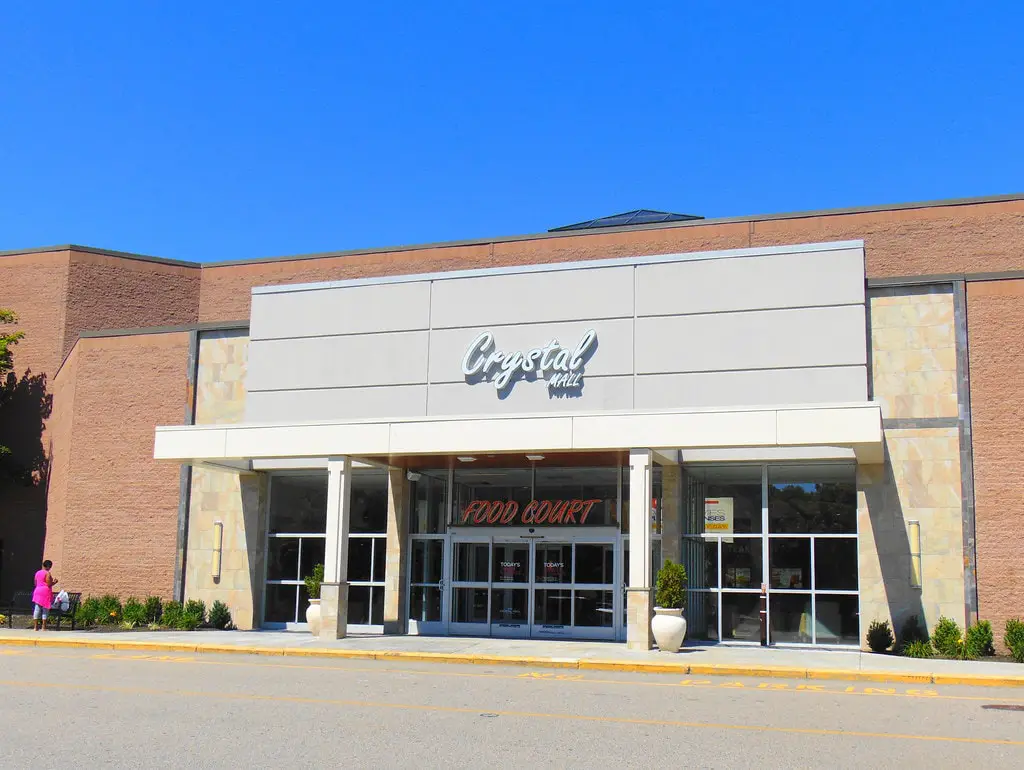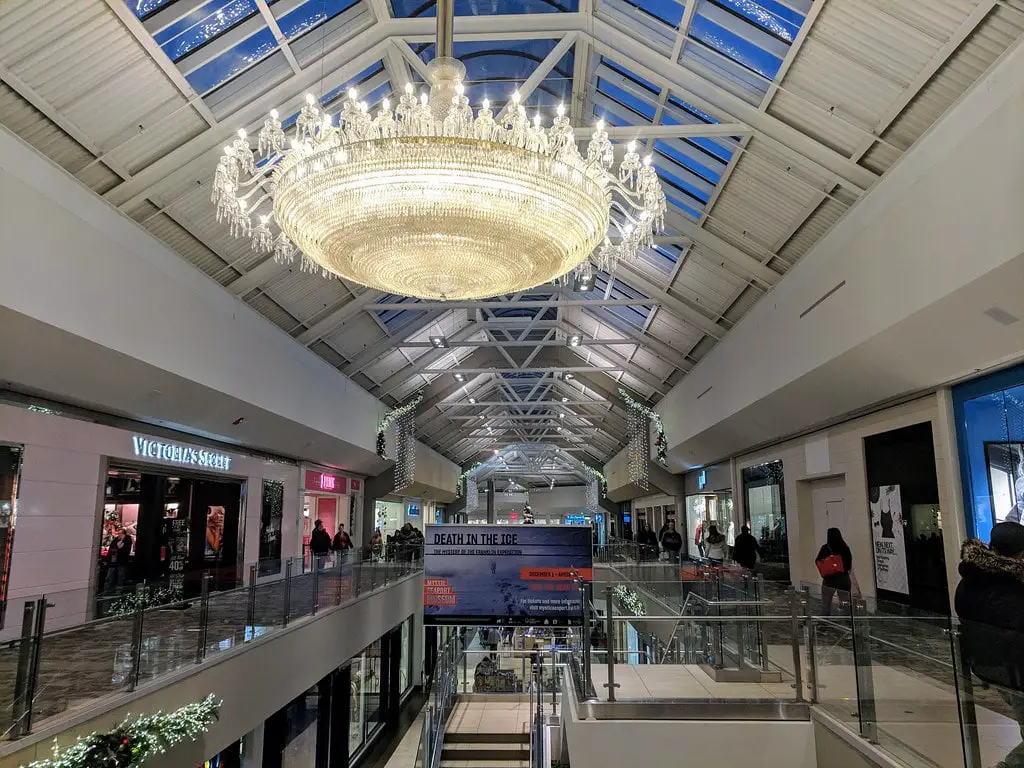The Rise of Crystal Mall
Crystal Mall opened its doors in Waterford, Connecticut, on September 30, 1984, marking the beginning of a new era in the region’s retail landscape. Developed by New England Development, this enclosed, two-level regional mall quickly established itself as a central retail hub.
Located off the Hartford Turnpike (Route 85), directly across from the smaller, open-air Waterford Commons, Crystal Mall became a pivotal point for shopping enthusiasts.
Crystal Mall has been home to various stores and services since its inception, boasting over 100 shops. The original anchor stores, which included Sears, Filene’s, JCPenney, and Jordan Marsh, were major draws for the local population and visitors alike.
These anchors were not just stores; they were the pillars that supported the mall’s bustling atmosphere and drove significant foot traffic.
The presence of these retail giants made Crystal Mall the only regional mall in the area, setting a high bar for competition and effectively overshadowing smaller shopping centers like the New London Mall, which later had to pivot to a “lifestyle center” model due to the stiff competition.
The mall’s strategic location and diverse store lineup catered to a wide trade area, serving Waterford and nearby towns such as Stonington, Norwich, Groton, and New London.
With a trade population of about 300,000 people, Crystal Mall became a go-to destination for shopping, dining, and entertainment. This made it an essential part of the community and a significant player in the local economy.
For those looking for things to do in Waterford, Connecticut, Crystal Mall offered various options, from shopping at well-known retail chains to dining at the food court.
The mall’s impact on the area was undeniable, providing a comprehensive shopping experience and becoming a central meeting point for the community.
As Connecticut’s ninth-largest mall, it represented a significant investment in the local retail sector. It set the stage for the area’s retail growth and development.
Architectural Evolution and Renovations
By the mid-1990s, Crystal Mall had begun to show signs of aging, particularly in its interior design and overall aesthetic. In response, mall management, recognizing the need to stay relevant and appealing to shoppers, initiated a series of renovations in 1997.
The goal was to modernize the mall and enhance the shopping experience for visitors. The upgrades included a significant overhaul of the interior design.
The previous darker color schemes were replaced with brighter, more inviting tones. This change aimed to create a more welcoming and pleasant environment for shoppers, encouraging them to spend more time and money at the mall.
The food court, a central gathering spot for mall visitors, received a comprehensive remodel. The new design aimed to provide a more comfortable and appealing dining area, catering to the diverse tastes of shoppers and enhancing the overall mall experience.
Additionally, improvements were made to the lighting and other fixtures throughout the mall, further contributing to the updated and modern feel.

One notable aspect of the renovation was the decision regarding the mall’s elegant center chandelier. Initially slated for removal, the chandelier had become a beloved feature among regular visitors.
In response to shopper feedback, mall management retained and refurbished the chandelier, allowing it to remain a focal point in its central atrium. This decision highlighted the importance of customer input in shaping the mall’s environment and offerings.
Despite these efforts, Crystal Mall faced criticism for its aging exterior. While the interior received a much-needed facelift, the external appearance of the mall remained largely unchanged, leading to perceptions that the mall still needed to be updated compared to newer shopping centers.
This discrepancy between the modernized interior and the older exterior presented a challenge for the mall in attracting new tenants and customers.
Decline of Traditional Anchors
The retail landscape shifted dramatically in the early 2000s, with traditional department stores facing increasing challenges from online shopping and changing consumer behaviors.
Crystal Mall was not immune to these trends, and its anchor stores, once the pillars of the mall’s retail offering, began to experience significant changes.
In 2006, Filene’s, one of the original anchor stores, closed its doors. This closure was part of a broader trend affecting many New England malls, as Filene’s and Macy’s, both present in numerous locations, were consolidated under the Macy’s brand following the acquisition of The May Department Stores Company by Federated Department Stores (now Macy’s, Inc.).
The loss of Filene’s at Crystal Mall was a significant blow, as anchor stores traditionally draw substantial foot traffic, which benefits smaller retailers within the mall.
Another original anchor, Sears, announced its closure in 2018 as part of its broader strategy to reduce its physical retail presence and focus on fewer profitable stores.
This was part of a nationwide trend of Sears store closures, reflecting the struggling fortunes of the once-dominant retail giant.
The wave of closures continued into the 2020s; on January 6, 2021, Macy’s announced its departure from the shopping center, shifting focus to its higher-performing locations as part of a strategic realignment.

Bed Bath & Beyond and Christmas Tree Shops, which moved into the space vacated by Filene’s in 2008, both closed in 2022-23, respectively.
These closures indicated the broader challenges facing brick-and-mortar retail stores, particularly those traditionally reliant on large, physical retail spaces.
The departure of these key tenants left JCPenney as the sole remaining original anchor, a stark indicator of the mall’s declining appeal and the changing retail environment.
The loss of anchor stores reduced the mall’s ability to attract visitors and had a ripple effect on smaller stores, many of which relied on the foot traffic generated by these larger retailers.
JCPenney – The Final Anchor
JCPenney stood as the last of the original anchor stores at Crystal Mall, opening its doors alongside the mall in 1984.
JCPenney remained a constant as other anchors departed, serving as a crucial draw for the mall’s foot traffic and maintaining stability amid the shifting retail landscape.
The store offered a wide range of products, from clothing and accessories to home goods, appealing to a broad customer base and anchoring the shopping experience at Crystal Mall.
However, the retail environment continued to evolve, with increasing competition from online platforms and changing consumer preferences. These challenges were not unique to Crystal Mall but reflected broader trends affecting malls and department stores nationwide.
In this context, the announcement on February 9, 2024, that JCPenney would be closing by the end of spring marked a significant moment for Crystal Mall.
The closure of JCPenney, slated for May 25, 2024, signaled the end of an era for the mall, leaving it without any of its original anchor tenants for the first time since its opening. The departure of JCPenney is expected to have a profound impact on Crystal Mall.
Current State and Tenant Mix
Despite the challenges faced by Crystal Mall, including the loss of its anchor stores, the mall continues to house a diverse mix of tenants.
As of early 2024, the mall’s lineup includes a variety of stores and services, ranging from fashion and accessories to technology and entertainment.
Notable tenants include Dollar N Things, Ebony & Ivory, and Men’s Wearhouse. These stores cater to various consumer needs and preferences, contributing to the mall’s role as a local shopping and entertainment destination.
In addition to retail stores, Crystal Mall offers several dining options and services. Eateries such as Buffalo Wild Wings, Sarku Japan, Froyo World, Dairy Queen, and Wok Express provide visitors with various food choices.

At the same time, service-oriented businesses like Mr. Fix It, Treat Yourself, and A New You Massage Spa offer practical and leisure services.
The presence of these businesses highlights the mall’s shift towards a more diverse tenant mix, moving beyond traditional retail to include a broader range of services and experiences.
The current tenant mix reflects the changing dynamics of retail and the efforts of mall management to adapt to new market realities.
By diversifying the types of businesses within the mall, management aims to attract different customer segments and provide reasons for visitors to come beyond traditional shopping.
This strategy is particularly important in the context of declining foot traffic and the challenges faced by brick-and-mortar retail.
However, the success of this approach will depend on the mall’s ability to continue attracting and retaining a diverse range of tenants and customers in the coming years.
Future Prospects and Redevelopment Ideas
As Crystal Mall faces the reality of a changing retail landscape, the focus shifts to the future of this once-thriving shopping center.
The departure of JCPenney, the last original anchor, marks a turning point, prompting stakeholders to consider redevelopment and repurposing options.
The challenge lies in transforming the large, underutilized space into something that meets the needs and interests of the community while remaining economically viable.
Several ideas have been floated for the future of Crystal Mall. These range from converting the mall into a mixed-use development that includes retail, residential, and office spaces to more community-oriented solutions like creating a hub for local arts, education, and health services.

Such transformations could breathe new life into the mall, making it relevant and useful in today’s economy and society.
The potential for redevelopment also opens up discussions about sustainable and community-focused design, incorporating green spaces, public amenities, and services that cater to a broad demographic.
The goal would be to create a space that serves the area’s economic interests and enhances the quality of life for residents.
As these discussions continue, the future of Crystal Mall remains uncertain. Still, the hope is that whatever direction is taken will lead to a revitalized and vibrant community asset.
